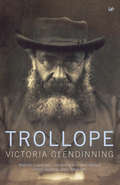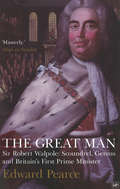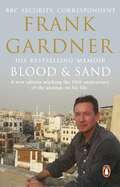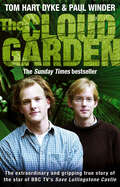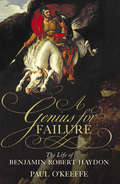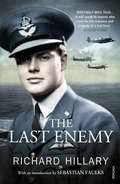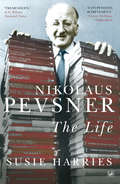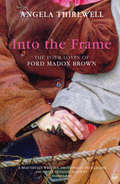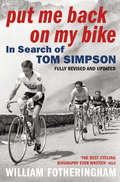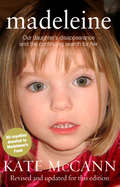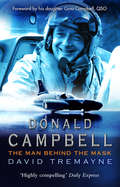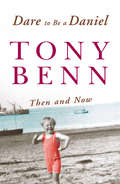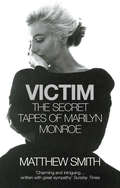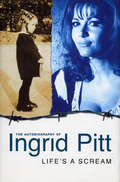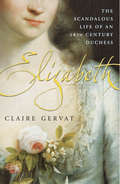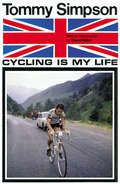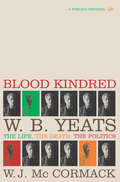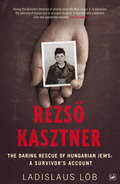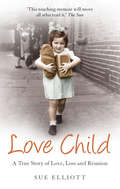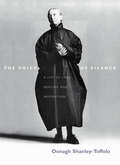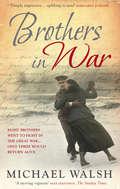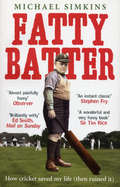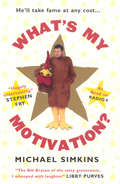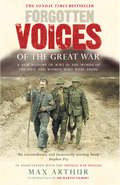- Table View
- List View
Trollope (The\complete Novels Of Anthony Trollope Ser.)
by Victoria GlendinningVictoria Glendinning provides a woman's view of Anthony Trollope, placing emphasis on family, particularly on his relationship with his mother. But it is Anthony as a husband and lover that intrigues her most. She looks at the nature of his love for his wife, Rose and at his love for Kate Field.
The Diaries Of Charles Greville
by Edward PearceCharles Greville (1794-1865) made his first occasional diary entries in 1814, but the diary only became a regular habit in the mid-1820s, continuing with occasional breaks, about which he is self-reproachful, through the reigns of George IV, William IV and Victoria. Finally, in 1860, after shaking his head over the worrying triumphs of Garibaldi, he closed it, once and for all. The grandson of a duke, Greville looked with a level and scornful eye upon royalty. George was 'the most worthless dog that ever lived'; William 'the silliest old gentleman in his own dominions, but what can be expected of a man with a head like a pineapple?' The diaries roused Queen Victoria - 'an odd woman' - from the lethargy of her widowhood.She spoke of Greville's 'indiscretion, indelicacy, ingratitude toward friends, betrayal of confidence and shameful disloyalty'.Greville's circle included Talleyrand, Wellington, Macaulay, Sydney Smith, Princess Lieven, Lord Grey, Melbourne, Guizot and Disraeli, as well as 'jockeys, bookmakers and blackguards'.As Clerk of the Privy Council, Greville works for a compromise on the Reform Bill.He witnesses Covent Garden theatre burning down.His closest friend, Lord De Ros, is caught cardsharping. Visiting Balmoral, he finds Albert and Victoria living 'not merely like small gentlefolks, but like very small gentlefolks'. When cholera comes, he writes laconically of 'Mrs Smith, young and beautiful, taken ill while dressing for Church and dead by nightfall.' Not a chatterbox, Charles Greville brilliantly assembles everyone else's chatter. This is the intelligent voice of another age, an uneasy aristocrat catching history on the turn and looking dubiously at the future.
The Great Man: Sir Robert Walpole: Scoundrel, Genius and Britain's First Prime Minister
by Edward PearceThe year 1721 has many splendours: great houses built by William Kent, fine pictures and the fruits of commerce. But there are also thirteen public hanging days a year, drunkenness is endemic, organised crime rampages through the streets. And politics are ferocious. Only a generation earlier, The Pretender failed to take the Crown; the new King is cursed as a damned foreigner; James's followers - the Jacobites - conspire and are persecuted; the South Sea Bubble collapses.Robert Walpole, once imprisoned for financial chicanery, assumes political control and becomes 'Prime Minister'. He personally detects a Jacobite plot, is dismissed in 1727 on the death of George I, recruits the new King's clever wife, Caroline, and bounces cheerfully back. Coarse, corrupt and cynical, Walpole dominates King, Parliament and Government until 1742. This is Mr Worldywiseman, keeping England out of war for twenty years and setting up a stable and growing economy. All politics of a kind we can recognise today begin with Robert Walpole. And here, in Edward Pearce's elegant book, he is brought vividly back to life.
Blood and Sand: The BBC security correspondent’s own extraordinary and inspiring story
by Frank GardnerOn the June 6, 2004, while on assignment in Riyadh, BBC security correspondent Frank Gardner and cameraman Simon Cumbers were ambushed by Islamist gunmen. Simon was killed outright. Frank was hit in the shoulder and leg. As he lay in the dust, a figure stood over him and pumped four more bullets into his body at point-blank range...Against all the odds, Frank Gardner survived. Today, although partly paralysed, Frank continues to travel the world, reporting and making documentaries for the BBC. This acclaimed memoir was brought up to date with a new chapter that recounted his return to Saudi Arabia for the first time since he was shot and the story he tells continues to move and inspire, and remains an affirmation of his deep understanding of - and affection for - the Islamic world in these uncertain times.___'Gardner tells his remarkable tale well and bravely, with an astonishing lack of anger and enduring love and respect for the Islamic world' SUNDAY TIMES'Brave, unsentimental and genuinely inspiring' EVENING STANDARD 'What makes Gardner's moving, often humorous, deeply personal story so important is the fact that he has woven into it a brilliantly dispassionate, clear-eyed account of the Islamic world' SCOTSMAN'A witty, self-deprecating, inspiring testament' DAILY TELEGRAPH
The Cloud Garden
by Paul Winder Tom Hart DykeThe Darién Gap is a place of legend. The only break in the Pan-American highway, which runs from Alaska to the tip of South America, it is an almost impregnable strip of swamp, jungle and cloud forest between the vast landmasses of North and South America. Stories of abduction and murder there are rife and in recent years more people have successfully climbed Everest or trekked to the South Pole than have crossed the Darién Gap. In 2000, Tom Hart Dyke, a young botanist, set off to Central America with one thing on his mind: orchids. He knew that in order to find the rare and beautiful species he so fervently admired, he would have to visit some of the most inhospitable places on earth. Unbeknown to Tom, another young explorer, Paul Winder, was backpacking through the area at the same time. Though he sometimes worked freelance in the City of London, Paul was a fearless and intrepid traveller, happier scaling volcanoes than lounging on beaches. In every bar and café along his route, rumours abounded of the Darién Gap - and the more he heard, the greater became his desire to make the journey. Pure chance brought Paul and Tom together in northern Mexico; they formed an instant bond and their fate was sealed. Ignoring a final, succinct warning from the Lonely Planet guide - 'Don't even think about it!' - Tom and Paul set off into the Darién: Tom in search of orchids, Paul in search of adventure. They would find plenty of each. For six days they made good progress. Then, just hours away from Colombia, the dream ended and the horror began. Paul and Tom were ambushed by FARC guerrillas who were to hold them hostage for the next nine months. From that day on, their survival was a matter of extraordinary endurance, incredible ingenuity and not a little good luck ...
A Genius for Failure: The Life of Benjamin Robert Haydon
by Paul O'Keeffe* Haydon's first attempt at suicide ended when the low calibre bullet fired from his pistol fractured his skull but failed to penetrate his brain. * His second attempt also failed: a deep slash across his throat left a large pool of blood at the entrance to his studio, but he was still able to reach his easel on the opposite side of the room. *Only his third attempt, another cut to the throat which sprayed blood across his unfinished canvas, was successful. He died face-down before the bespattered 'Alfred and the First British Jury', his final bid 'to improve the taste of the English people' through the High Art of historical painting.* Such intensity, struggle and near-comic inability to succeed encapsulate Haydon's career. Thirty years before his death his huge, iconic paintings had made him the toast of early 19th-century London, drawing paying crowds to the Egyptian Hall in Piccadilly for months and leading to nationwide tours. * However, his attempt to repeat such success three months before his death was to destroy him: barely a soul turned up, leaving the desperate painter alone, humiliated, and facing financial ruin. * In A Genius for Failure Paul O'Keeffe makes clear that the real tragedy of Haydon lay in the extent to which his failures were unwittingly engineered by his own actions - his refusal to resort to the painting of fashionable portraits, for example, and his self-destructively acrimonious relationship with the RA.* The company he kept - Keats, Shelley, Wordsworth, Sir Robert Peel and the Duke of Wellington, among many others - and the momentous events he lived through - The Battle of Waterloo, the Coronation of George IV, and the passing of the first Parliamentary Reform Bill - make A Genius for Failure not only the definitive biography of this fascinating and tragic painter, but a stirring portrayal of an age.
The Last Enemy: The Centenary Collection (G - Reference,information And Interdisciplinary Subjects Ser.)
by Richard HillaryThe Last Enemy is the story of Richard Hillary, one of Sebastian Faulks' three 'fatal englishmen'. In this extraordinary account, the author details his experiences as a fighter pilot in the Second World War, in which he was shot down, leading to months in hospital as part of Archibald McIndoe's 'Guinea Pig Club', undergoing pioneering plastic surgery to rebuild his face and hands. The Last Enemy was first published in 1942, just seven months before Hilary's untimely death in a second crash and has gone on to be hailed as one of the classic texts of World War Two.
Nikolaus Pevsner: The Life
by Susie HarriesBorn Nikolai Pewsner into a Russian-Jewish family in Leipzig in 1902, Nikolaus Pevsner was a dedicated scholar who pursued a promising career as an academic in Dresden and Göttingen. When, in 1933 Jews were no longer permitted to teach in German universities, he lost his job and looked for employment in England. Here, over a long and amazingly industrious career, he made himself an authority on the exploration and enjoyment of English art and architecture, so much so that his magisterial county-by-county series of 46 books on The Buildings of England (first published 1951 - 74) is usually referred to simply as 'Pevsner'. As a critic, academic and champion of Modernism, Pevsner became a central figure in the architectural consensus that accompanied post-war reconstruction; as a 'general practitioner' of architectural history, he covered an astonishing range, from Gothic cathedrals and Georgian coffee houses to the Festival of Britain and Brutalist tower blocks.Susie Harries explores the truth about Nikolaus Pevsner's reported sympathies with elements of Nazi ideology, his internment in England as an enemy alien and his sometimes painful assimilation into his country of exile. His Heftchen - secret diaries he kept from the age of 14 for another sixty years - reveal hidden aspirations and anxieties, as do his numerous letters (he wrote to his wife, Lola, every day that they were apart).Harries is the first biographer to have read Pevsner's private papers and, through them, to have seen into the workings of his mind.Her definitive biography is not only rich in context and far-ranging, but is also brought to life by quotations from Pevsner himself. He was born a Jew but converted to Lutheranism; trained in the rigour of German scholarship, he became an Everyman in his copious commissions, publications, broadcasts and lectures on art, architecture, design, education, town planning, social housing, conservation, Mannerism, the Bauhaus, the Victorians, Zeitgeist, Englishness and how a nation's character may, or must, be reflected in its art. His life - as an outsider yet an insider at the heart of English art history - illuminates both the predicament and the prowess of the continental émigrés who did so much to shape British culture after 1945.
Into The Frame: The Four Loves of Ford Madox Brown
by Angela ThirlwellMadox Brown, who grew up in France and Belgium before he came to England and won fame with paintings like 'The Last of England', was always an outsider, and the women he loved also burst out of stereotypes. His two wives, Elisabeth Bromley and Emma Hill, and his secret passions, the artist Marie Spartali and the author Mathilde Blind, were all remarkable personalities, from very different backgrounds.Their striving for self-expression, in an age that sought to suppress them, tells us much more about women's journey towards modern roles. Their lives - full of passion, sexual longing, tragedy and determination - take us from the English countryside and the artist's studio to a Europe in turmoil and revolution. These are not silent muses hidden in the shadow of a 'Master'. They step out of the shadows and into the picture, speaking with voices we can hear and understand.
Put Me Back on My Bike: In Search of Tom Simpson
by William FotheringhamDiscover the story of Britain’s ultimate cyclist and his ill-fated race during the 1967 Tour de France, from the bestselling author of Half Man Half BikeTom Simpson was an Olympic medallist, world champion and the first Briton to wear the fabled yellow jersey of the Tour de France. He died a tragic early death during the 1967 Tour. A man of contradictions, Simpson was one of the first cyclists to admit to using banned drugs, and was accused of fixing races, yet the dapper 'Major Tom' inspired awe and affection for the obsessive will to win which was ultimately to cost him his life. Put Me Back on My Bike revisits the places and people associated with Simpson to produce the definitive story of Britain's greatest ever cyclist. The fully revised and updated edition of William Fotheringham's classic biography features a new foreword and postscript further exploring the truth behind the legend.‘The best cycling biography ever written' Velo ‘A beautiful explanation of why Simpson's legend still exerts such a powerful hold’ Sunday Times
Madeleine: Our daughter's disappearance and the continuing search for her
by Kate McCannKate McCann's personal account of the disappearance and continuing search for her daughter, revised and updated.'The decision to publish this book has been very difficult, and taken with heavy hearts ... My reason for writing it is simple: to give an account of the truth ... Writing this memoir has entailed recording some very personal, intimate and emotional aspects of our lives. Sharing these with strangers does not come easily to me, but if I hadn't done so I would not have felt the book gave as full a picture as it is possible for me to give. As with every action we have taken over the last five years, it ultimately boils down to whether what we are doing could help us to find Madeleine. When the answer to that question is yes, or even possibly, our family can cope with anything ... Nothing is more important to us than finding our little girl.' -- Kate McCann'A must-read' Sunday Express'Kate's book blazes with the sheer visceral force of her love for her daughter' Daily Mail'Deeply moving' Guardian
Donald Campbell: The Man Behind The Mask
by David TremayneGenerations are familiar with the haunting black and white television footage of Donald Campbell somersaulting to his death in his famous Bluebird boat on Coniston Water in January, 1967. It has become an iconic image of the decade. His towering achievements, and the drama of his passing, are thus part of the national psyche. But what of the man himself? The son of the legendary Sir Malcolm Campbell who was famous for being the ultimate record-breaker of the inter-war years - he broke the land speed record nine times and the water speed record four times with his Bluebird cars and boats - Donald Campbell was born to speed. He was outgoing and flamboyant, yet carefully orchestrated the image he presented to the world. Some saw him as a playboy adventurer; others, such as the radio producer on the twenty-first anniversary of his death, as a reckless daredevil with a death wish. He was known to take solace in extra-marital dalliances, and was obsessed with spiritualism. And in his final years, battered by a 360-mph accident while attempting the land record on the Bonneville Salt Flats in Utah, and his prolonged and anti-climactic subsequent effort on the treacherous Lake Eyre in Australia, Campbell appeared a haggard and often frightened man. He had become trapped on his record-breaker's treadmill as he continually sought to prove himself to his illustrious father, in whose long shadow he felt forever trapped. DONALD CAMPBELL: THE MAN BEHIND THE MASK paints a fascinating portrait of an intense, complex, superstitious yet abnormally brave man who was driven not only by the desire to prove that he was worthy of the mantle of his father, but also by his fervent and unswerving desire to keep Britain at the forefront of international speed endeavour. This book generates a unique insight into how his desperate fear of failure finally lured him into taking one risk too many.
Dare To Be A Daniel: Then and Now
by Tony BennBorn into a family with a strong, radical dissenting tradition in which enterprise and public service were combined, Tony Benn was taught to believe that the greatest sin in life was to waste time and money. Life in his Victorian-Edwardian family home in Westminster was characterised by austerity, the last vestiges of domestic service, the profound influence of his mother, a dedicated Christian and feminist, and his colourful and courageous father, elected as a Liberal MP in 1906 and later serving in Labour Cabinets under Ramsay MacDonald and Clem Atlee. Benn followed in his father's footsteps, becoming one of the most famous and respected figures in modern British politics.Dare to be a Daniel feelingly recalls Tony Benn's years as one of three brothers experiencing life in the nursery, the agonies of adolescence and of school, where boys were taught to 'keep their minds clean' and the shadow of fascism and the Second World War with its disruption and family loss. This moving memoir also describes his emergence from World War Two as a keen socialist about to embark upon marriage and an unknown political future. The book ends with some of Tony Benn's reflections on many of the most important and controversial issues of our time.
Victim
by Matthew SmithSuicide? Or murder? Marilyn Monroe's death in August 1962, apparently a suicide, shocked the world. A Hollywood star, a global icon, why would she have killed herself? Yet the coroner's report stated her death was due to a massive overdose of 47 Nembutal capsules. But what about the discrepancies between the official report and the scene of her death? What about the forensic evidence that went missing shortly after she died? Matthew Smith has constructed a startling new version of events. His interpretation is based not only on the full and true forensic evidence from the time, but also on the tapes that Marilyn made for her psychiatrist in the days and weeks before her death, tapes that portray a woman in full charge of her life and looking forward to a bright, busy, successful future. Forty years after her death, Marilyn remains an icon and a mystery. Matthew Smith's investigation into her death will lead to a new understanding of what really happened on the night of August 5th 1962 and in the weeks leading up to it.
Life's A Scream
by Ingrid PittAt the age of five, Ingrid Pitt found herself in a concentration camp. Ingrid and her mother escaped from the guards while on a forced march and presented themselves to the partisans, unsure if they would kill them. They spent the rest of the war in the forests. Ingrid fell in love for the first time and watched in despair as British bombers flew overhead. She still cannot see the vapour trials of planes without being transported back to her childhood vigil. After the war Ingrid came to London, where she developed a career as a Hammer House of Horror movie star, but, as she proundly says, `I was always the biter, never the bitten!' She also acted in mainstream films, such as WHERE EAGLES DARE. She had a child by her first marriage and a grand passion which lead to her marrying a racing driver. They lived in Argentina for a while and were good friends of President Peron and Isabelits Peron. Ingrid even spent an evening with the embalmed body of Eva Peron. Written with great passion and warmth, this is a rare childhood memoir and the story of Hammer`s most galmorous actress. Above all, this is a story of a survivor.
Elizabeth: The Scandalous Life of an 18th Century Duchess
by Claire GervatElizabeth Chudleigh was one of the eighteenth century's most colourful characters. Born into impoverished gentility, her beauty, wit and vitality soon earned her a place at the centre of court life. When she married the Duke of Kingston in 1769 she had reached the highest rung of the social ladder. But Elizabeth was carrying a dark secret. In 1744 she had secretly married a naval lieutenant called Augustus Hervey, and after the Duke's death her first marriage was discovered. Bigamy fever swept London society and, in a very public trial, Elizabeth was found guilty. But her strength of character ensured that, even when her friends deserted her, her courage and zest for life did not. In an engaging history of this strong and wilful woman, Gervat shows there was far more to Elizabeth than the caricature villain her contemporaries made her out to be.
Cycling is My Life
by Tommy SimpsonThe cyclist Tom Simpson is a legend. The first British world champion, the first Briton to pull on the fabled yellow jersey of the Tour de France - he brought professional cycling to a nation and inspired generations of riders. His autobiography, Cycling is My Life, was written the year before he died tragically on the barren moonscape of Mont Ventoux during the 1967 Tour aged just twenty-nine. Forty years on, hundreds of fans still make the pilgrimage to the windswept memorial which marks the spot where he died. In an age where each Tour de France seems more blighted by scandal than the next, Simpson's story is as relevant now as it was then. A man of contradictions, Simpson was one of the first cyclists to admit to using banned drugs, yet the dapper 'Major Tom' inspired awe and affection from the British public for the obsessive will to win which was ultimately to cost him his life. First published in 1966, Simpson's autobiography is essential reading for every dedicated cycling fan and an engaging story of the life of an iconic sportsman.
Blood Kindred: W. B. Yeats, the Life, the Death, the Politics
by W J McCormackIn June 1934, W. B. Yeats gratefully received the award of a Goethe-Plakette from Oberburgermeister Krebs, four months after his early play The Countess Cathleen had been produced in Frankfurt by SS Untersturmfuhrer Bethge. Four years later, the poet publicly commended Nazi legislation before leaving Dublin to die in southern France. These hitherto neglected, isolated and scandalous details stand at the heart of this reflective study of Yeats's life, his attitudes towards death, and his politics.Blood Kindred identifies an obsession with family as the link connecting Yeats's late engagement with fascism to his Irish Victorian origins in suburban Dublin and industrializing Ulster. It carefully documents and analyses his involvement with both Maud Gonne and her daughter Iseult, his secretive consultations with Irish army officers during his Senate years, his incidental anti-Semitism, and his approval of the right-wing royalist group L'Action Française in the 1920s. The familiar peaks and troughs of Irish history, such as the 1916 Rising and the death of Parnell, are re-oriented within a radical new interpretation of Yeats's life and thought, his poetry and plays. As far as possible Bill McCormack lets Yeats speak for himself through generous quotation from his newly accessible correspondence. The result is a combative, entertaining biography which allows Ireland's greatest literary figure to be seen in the round for the first time.
Rezso Kasztner: The Daring Rescue of Hungarian Jews: A Survivor's Account
by Ladislaus LöbTwo months after his eleventh birthday, on 9 July 1944, the gates of Bergen-Belsen concentration camp closed behind Ladislaus Löb. Five months later, with the Second World War still raging, he crossed the border into Switzerland, cold and hungry, but alive and safe. He was not alone, but part of a group of some 1,670 Jewish men, women and children from Hungary, who had been rescued from the Nazis as a result of a deal made by a man called Rezso Kasztner - himself a Hungarian Jew - with Adolf Eichmann, the chief architect of the Holocaust. Twelve years and a miscarriage of justice later Kasztner was murdered by an extremist Jewish gang in his adopted home of Israel. To this day he remains a highly controversial figure, regarded by some as a traitor and by many others as a hero. He was accused of betraying the bulk of the Hungarian Jewry by hand-picking only those who were politically and personally dear to him, or those from whom he could benefit financially, and the judge of his post-war trial concluded that he had 'sold his soul to Satan'.Rezso Kasztner tells his story - and also the story of a child who lived to grow up after the Holocaust thanks to him. A compelling combination of history and memoir, it is also an examination of one individual's unique achievement and a consideration of the profound moral issues raised by his dealings with some of the most evil men ever known.
Love Child
by Sue ElliottAdoption is one of the great, untold stories of our recent past. It is a truly epic tale of loss, guilt, identity, family feuds, reunion and redemption. It is a subject, until very recently, surrounded by secrecy and taboos. This is the heart-warming true story of a little girl's adoption in the 1950s and her search, nearly forty years later, for her birth mother. When mother and daughter meet, Sue thinks she has finally reached the end of her journey. Then Sue discovers she wasn't the only baby her mother gave away ...Weaved throughout is the vivid, emotional history of adoption in the UK. Drawing on a wide range of intimate personal experiences, it outlines the forces that shaped 20th century adoption practice, from baby-farming, the stigma of illegitimacy, incest and the bastardy laws, to children taken by force, the Magdalene laundries, mass emigration schemes without parental consent, to modern day adoption practices, buying babies from abroad, sperm donor fathers and tearful reunions on Trisha.
The Voice Of Silence: A Life of Love, Healing and Inspiration
by Oonagh Shanley-ToffoloThe Voice of Silence is by an Irishwoman who has had an extraordinary life. Oonagh Shanley-Toffolo was brought up in 1930s rural Ireland where her father initiated her into the healing arts. At the age of 16, she entered a convent where she trained as a nurse, and was sent to India to look after the elderly (and knew Mother Teresa). Here, she felt it was the young, rather than the old, who needed more help and so she left her order and trained in midwifery. Later, in Paris, she was asked to nurse the Duke of Windsor just before he died - and many years later was introduced to Princess Diana and became her weekly confidante. In between, were bouts of serious illness, studying acupuncture in China - and being photographed by Snowdon. The Voice of Silence is the life story of a very unusual woman who has learned far more than most from all the remarkable things that have happened to her. It is also the author's thoughts on healing, spirituality and love - and how closely the three are intertwined. Full of feeling, poetic vision and insight, this book cannot fail to touch the heart of the reader, and inspire.
Brothers in War
by Michael WalshBrothers in War is the immensely powerful and deeply tragic story of the Beechey brothers, and how they paid the ultimate price for King and country. All eight went to fight in the Great War on such far-flung battlefields as France, Flanders, East Africa and Gallipoli. Only three would return alive. Even amid the carnage of the trenches, it was a family trauma almost without parallel. Their wives and sweethearts were left bereft, their widowed mother Amy devastated. It is a tragedy that has remained forgotten and unmarked for nearly 90 years. Until now.Kept in a small brown case handed down by the brothers' youngest sister, Edie, were hundreds of letters sent home from the front by the Beechey boys: scraps of paper scribbled on in the firing line, heartfelt messages written from a deathbed, exasperated correspondences detailing the absurdities of life in the trenches. From it all emerges the remarkable tale of the lost brothers.Tragic and moving, poetic in its intensity, Brothers in War reveals first-hand the catastrophe that was the Great War; all told through one family forced to sacrifice everything.
Fatty Batter: How cricket saved my life (then ruined it)
by Michael SimkinsA fat boy with a passion for sweets and a loathing for games, the young Michael Simkins finds in cricket a sport where size doesn't necessarily matter and a full-blown obsession is born. Now in middle-age, he still harbours the somewhat deluded belief that the England middle-order might usefully benefit from his hard-earned skills. From impromptu Test series played with his dad in the family sweetshop through to his years running a team of dysfunctional inadequates, Fatty Batter is the bestselling and hilarious story of one man's life lived through cricket.
What's My Motivation?
by Michael SimkinsAs a boy, Michael Simkins always wanted to be someone. While his friends were out getting laid and stoned, he was tucked up at home dreaming of his name in lights, of holding an audience rapt, of perhaps becoming a TV heart-throb, or having someone, anyone, ask for his autograph in the supermarket. This is the true story of an obsessive pursuit of acting fame. It is a life marked by occasional hard-fought successes and routine helpings of ritual humiliation: scout hut Gilbert and Sullivan, dodgy rock operas, sewage farm theatre workshop, Christmas panto hell, straight-to-video film flops, leading roles in Crimewatch reconstructions and dressing up as a chicken to advertise TV dinners. It is a hilarious tale of turgid theatre, tights, trusses and tonsil tennis with Timothy Spall.
Forgotten Voices Of The Great War
by Max ArthurIn 1960, the Imperial War Museum began a momentous and important task. A team of academics, archivists and volunteers set about tracing WWI veterans and interviewing them at length in order to record the experiences of ordinary individuals in war. The IWM aural archive has become the most important archive of its kind in the world. Authors have occasionally been granted access to the vaults, but digesting the thousands of hours of footage is a monumental task. Now, forty years on, the Imperial War Museum has at last given author Max Arthur and his team of researchers unlimited access to the complete WWI tapes. These are the forgotten voices of an entire generation of survivors of the Great War. The resulting book is an important and compelling history of WWI in the words of those who experienced it.
